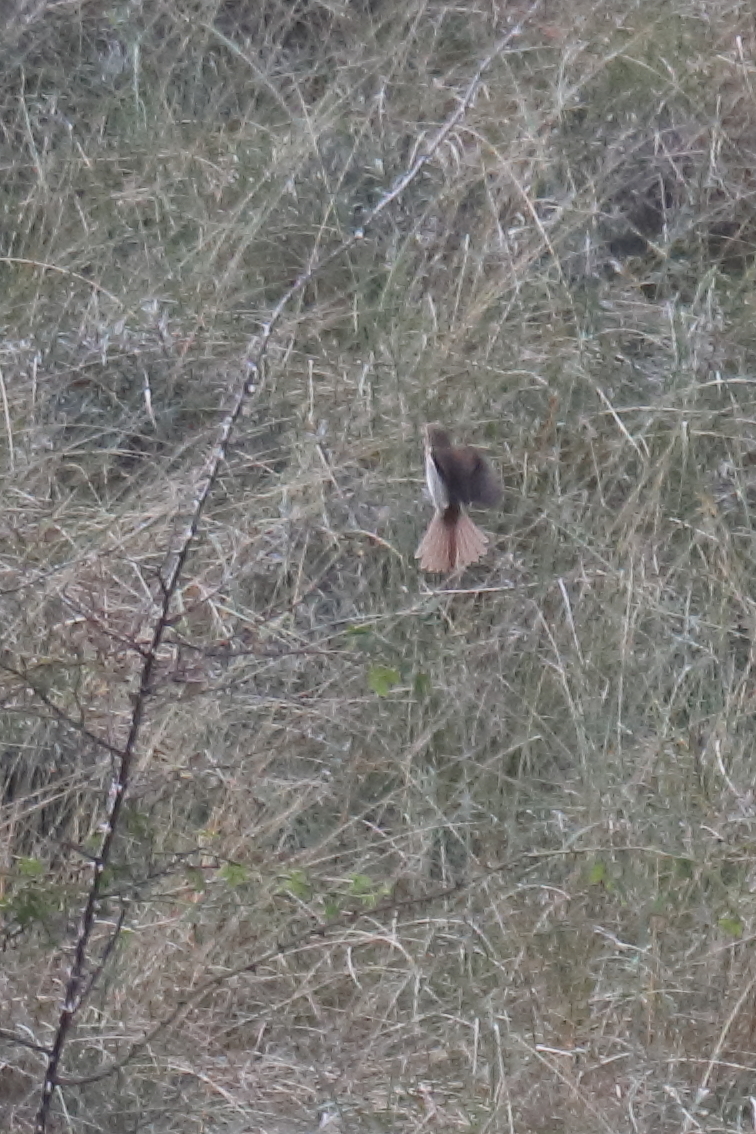Edit: t1 is bij nummering van staartpennen (meestal) de binnenste staartpen, dus ik bedoel hier t6 ( buitenste).
Fotogalerij
| Mozaïek |
| Zeldzame soorten |
| Schaarse soorten |
| Overige |
| WP-soorten |
| Wereld-soorten |
| Determinatie |
| Historie |
| Dutch Bird Alerts |
| Dutch Birding 40 jaar |
| België |
| Belgian Bird Alerts |
| Zeldzaamheden België |
Bruine Klauwier
Lanius cristatus · Brown Shrike
| Datum | 3 oktober 2019 |
|---|---|
| Locatie | Vlieland duinen noord van Kazerne KLu |
| Fotograaf |
|
| Bekeken | 6829 × |
| Getrapte staart zichtbaar (korte t1) |
Discussie
Niels Gilissen · 12 oktober 2019 15:53
Geir Mobakken · 24 februari 2024 16:52
Not convincingly short outer tail feathers.
Jan van der Laan · 24 februari 2024 23:43, gewijzigd 24 februari 2024 23:50
Normal tail for Brown Shrike in October. In winter the moult starts and therefore lot of pictures show shorter t6's, which are growing.
Geir Mobakken · 26 februari 2024 16:21
Interesting information. So the other Brown Shrikes turning up in Europe showing a wide gap between T5 and T6 must be atypical birds then?
Jan van der Laan · 26 februari 2024 18:46, gewijzigd 27 februari 2024 09:51
The first Brown Shrike for the Netherlands in 2014 had an almost similar tail; and here seen from beneath.
This what I meant with moulting tail, a bird from the Phillipines in April 2013.
Jan van der Laan · 26 februari 2024 20:14, gewijzigd 26 februari 2024 20:14
Some more background: tail length is 76-88 mm (n=41) and the graduation of the tail (length between shortest an longest tail feather) is 14-26 mm (Norevik et al, 2020, n=36)). Adult birds have a complete summer moult (SC) and a complete winter moult (WC), while young birds (1cy) have a partial summer moult (sp) and a complete winter moult (WC).
Geir Mobakken · 27 februari 2024 16:56
Jan: I’m still surprised at the small distance between T5 and T6 on the Dutch birds. For birds in juvenile plumage I thought tail graduation was the only diagnostic character, compared to Red-backed Shrike. There is no overlap, given as 15–25 mm for BS and 5–14 mm for RbS in Shirihai’s and Svensson’s HWPB (2018).
Checking images online showing the tail’s underside on sitting birds is an eye-opener.
I see no reason for the moult card: first-year birds in mid-autumn have full tails, and the first moult is not before late winter.
That said the Dutch birds are probably Brown Shrikes because other features point in that direction although the current bird seems not to have documentation that allows for finer details to be seen.
Max Berlijn · 27 februari 2024 19:37, gewijzigd 27 februari 2024 19:41
I think it is wise to give this Vlieland bird a second look by the Rarities Commitee. The other 3 records are well documented and show many other ID points so it should be safe to call them Brown Shrikes.
Jan van der Laan · 27 februari 2024 19:59, gewijzigd 27 februari 2024 20:15
@Max,
Then also the first bird please. It had a similar shaped tail.
@Geir
"If you encounter a contradiction, check your premises."
Could you estimate the graduation of the tail on that picture? Is it less than 15 mm. Another picture of the same bird, what is your guess, also less than 15 mm?
I have seen a lot of birds in southeast Asia where the outer tail feathers did not reach the half of the total tail. That is more than 25 mm. Therefore I consider that to be moult as the example I gave above from my own foto collection.
And for the lazy persons amongst us (not you Geir, I hasten to say), there were a lot a pictures taken from this bird that stayed from 3 October till 5 October 2019. Judge the ID for yourself.
Geir Mobakken · 27 februari 2024 21:07
Jan van der Laan · 27 februari 2024 22:03, gewijzigd 27 februari 2024 22:19
I wouldn't call a tail showing not more than seven tail feathers with a slight hint of asymetry unmoulted.
My question remains: what is your estimate of the tail graduation of the tail of the Vlieland bird? If you take into consideration that the bill from tip to nostril is c 11 mm (Cramp et al V7 1993, page 447). Would you come to the same estimate when you consider this picture.
Better pictures here, a 1st CY bird in September and a 2nd CY bird in May. Both from the good old Tarsiger site. On E-Bird, ploughing your way through 10,000 images is something I would not advise ;-). Both birds have fresh tails IMHO.
Geir Mobakken · 27 februari 2024 22:32
True, we don’t see all feathers but I think they are there, unmoulted in mid-May. Thing is this large gap is real and I think you know it.
I cannot answer your question, only that it has a tail-shape that fit Red-backed and at the same time look wrong for Brown.
Two more pictures before I call it a day.
Red-backed Shrike showing undertail
Brown Shrike showing undertail
Jan van der Laan · 27 februari 2024 22:51, gewijzigd 27 februari 2024 22:54
These are not to compare with the Vlieland bird as they show folded undertails. I get the point and I do not deny as I gave the measurements of the tail graduation 14-26 mm (based on the source I gave) and you gave the tail graduation of RB Shrike 5–14 mm (Svensson & Shirihai).
Both Dutch birds had other characters pointing to Brown Shrike and excluding RB Shrike: thick bill, short primary projection and uniform brown upperparts (that is back, mantle and head the same colour).
Or do we have to draw the hybrid card, because we cannot be sure if the tail graduation is less than 14 mm?
Geir Mobakken · 28 februari 2024 15:44
The new pictures from tarsiger.com you sent last night Jan were good ones indeed, but by including them you’re only building my case …
Jan van der Laan · 28 februari 2024 16:30, gewijzigd 28 februari 2024 16:53
You are right. They are Red-backed Shrikes. How stupid of us.
Vincent van der Spek · 28 februari 2024 20:42
Check this photo of the same bird, that shows only 3-4 primary tips reaching beyond the tertials.
Geir Mobakken · 28 februari 2024 23:24
Vincent: Looks good, and other features looks good too.
Jan: My only ‘right’ was to emphasize a surprising tail formula on the bird in the header picture.
Jan van der Laan · 29 februari 2024 06:39, gewijzigd 29 februari 2024 06:44
You can't have your cake and it. Is a Crane not a crane when the bill length falls 1 mm outside the known range? You don't yell at the boulder for being a rock.
Gebruikers van het forum gaan akkoord met de forumregels.
Forum spelregels
Dutch Birding Association beoogt met het forum in de fotogalerij de lezer een platform te bieden waarop informatief en inhoudelijk gediscussieerd kan worden over zeldzame en schaarse vogels. Het forum staat daarmee in het verlengde van het (semi-) wetenschappelijke karakter van het blad Dutch Birding.
Om het gebruik van het forum in goede banen te leiden, heeft Dutch Birding de volgende regels opgesteld: de moderatoren kunnen reacties verwijderen die
- een degelijke onderbouwing van de determinatie missen
- als beledigend of kwetsend kunnen worden ervaren door andere forumgebruikers
- off-topic zijn
- spam of reclame bevatten
- zij beschouwen als trolling
Auteurs die zich niet houden aan de bovenstaande regels krijgen een waarschuwing en bij herhaling van het overtreden van bovenstaande regels behoudt het DBA bestuur zich het recht voor om het account van de auteur te blokkeren.
De moderatoren hebben het recht om zonder opgaaf van reden, onder verwijzing naar de spelregels, reacties te verwijderen.
Erger je je aan het trollen van anderen, realiseer je dan dat met niet-reageren cq doodzwijgen het trollen het snelst stopt. Reageer niet! Sein de moderatoren in via foto@dutchbirding.nl, zodat zij gepaste actie kunnen ondernemen.


